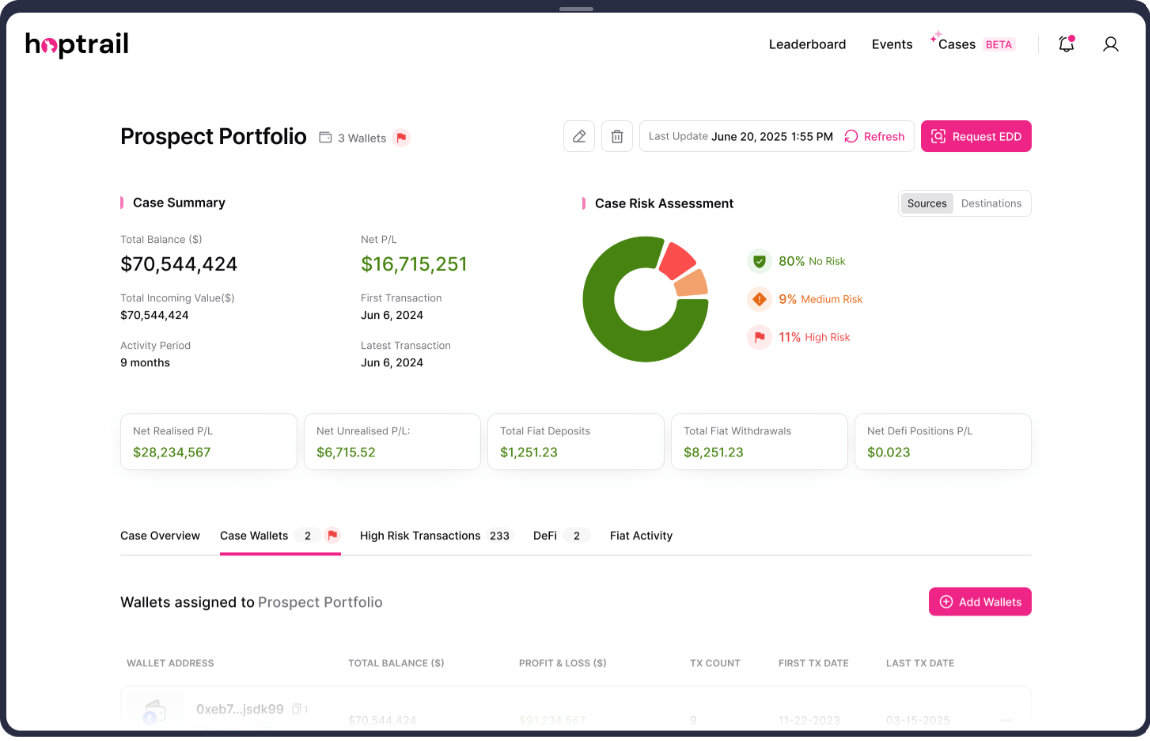Proof of Assets: exchange holdings and cold storage moves

In February, Hoptrail published its Solvency Transparency index, which measures the financial health of crypto exchanges. The index takes data disclosed by exchanges on asset holdings and audit procedures and uses it to compare and score financial transparency across venues.
The data provides us with a look at how well capitalised exchanges are in a post-FTX world; the size, quality and stability of their assets; and how those venues are handling cold storage.
Its something we think will be a central part of exchange disclosures in the future, and central to how the crypto sector demonstrates integrity. In this piece, we take a dive into data collated over the last six weeks on exchange assets as well as some hefty, unexpected cold storage movements.
Disclosed Asset Holdings
To date, only 22 exchanges have disclosed information on their crypto-asset holdings. A further ten have stated their intention to publish details but have yet to do so.
Since February, total disclosed assets has been tracking at around $80 billion across the 22 exchanges monitored. Binance accounts for around half of that - a figure which only includes their Ethereum, Bitcoin and ERC-20 assets.

Digging into Binance’s overall assets shows a relatively healthy picture. Blue chip assets like Bitcoin, Ethereum, USDT, and USDC account for around three-fifths of Binance’s asset base. BUSD makes up a further $6.5 billion. Hoptrail’s data shows these assets are fairly evenly split between hot and cold wallets, indicating the venue holds sufficient assets to cover customer funds.

In absolute terms, Binance’s total assets have declined the most among exchanges, losing $3.5 billion. Most of that has been a result of declining USDT and USDC holdings. Over the same period, Binance’s BTC holdings increased by 9.8%.
But in real terms, the percentage decline in total assets over the last six weeks is only 7.8%. That compares favourably against exchanges such as Crypto.com and Coinsquare, which lost 43% and 47.3% respectively in the same time period, based on assets held in disclosed wallets.

Why the sudden drop?
Crypto.com’s apparent decline was driven by a sharp drop in its ETH holdings, which fell 41%, and its BTC holdings, which dropped 20.3%. But the biggest decline was seen in Crypto.com’s non-stablecoin (and non-CRO) ERC-20 holdings, which fell 72% in six weeks. This is all derived from Crypto.com’s own disclosures from December 2022, though the published wallet addresses appear to have now been removed from the site and transferred entirely to Nansen.

The short fall is ultimately explained by asset movements recently undertaken by Crypto.com. In late March, the venue moved at least $325 million in BTC from known cold wallets to new storage locations without informing the market.
Crypto.com also moved around $380 million in ETH and almost $1 billion in ERC-20 tokens (including nearly $500 million in Shiba Inu) to a new wallet in mid-to-late March. These movements appear to have been made without any forewarning.
It is not clear whether this new location is a cold storage wallet. Interestingly, the source of most of the funds into this address is also its main recipient, but there may be good reasons for this. Crypto.com might be undertaking some necessary internal asset management.
The same issue appears true of Coinsquare too, which saw its BTC assets in disclosed wallets drop by over 70% on 28 March. Hoptrail’s tracing confirms around $83 million was moved on this day to a freshly created wallet. There does not seem to have been market communications on the transfers, and platforms collating data on PoA have not updated to account for the fund movement.
There is no rule on disclosing asset transfers, but the lack of communication on large fund movements may have unintended negative consequences. While these cases have not caused any concern this time, similar moves in the future might be read as a deterioration in holdings, liquidations, or a potential security breach - all of which can spook the markets without well-timed market disclosures.
In the past, certain venues have disclosed asset movements ahead of time. We suggest exchanges adopt regular forward warning on potential fund movements - particularly those in cold storage - to avoid speculation or sharp downward price movements.
Want to find out more?
If you’d like to find out more about our Solvency Transparency index, get in touch with the team at info@hoptrail.io or reach out to us here.
In next week’s PoA review, we take a look at the type and quality of assets held on exchanges.
ExchangesCold StorageProof of AssetsProof of

Cases: new source of wealth capabilities and upcoming features

Why we built Cases: A personal note on solving the crypto source of wealth headache

Hoptrail's Crypto Source of Wealth Reports: A Guide
Subscribe to the Hoptrail newsletter
Sign up with your email address to get the latest insights from our crypto experts.
